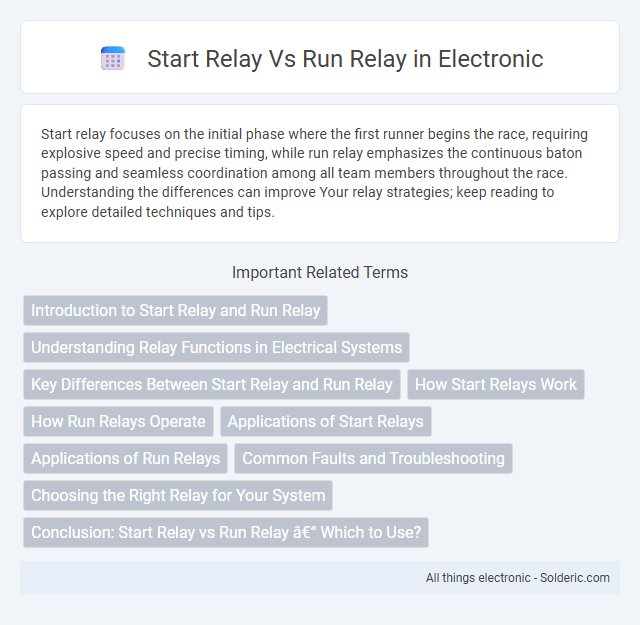Start relay focuses on the initial phase where the first runner begins the race, requiring explosive speed and precise timing, while run relay emphasizes the continuous baton passing and seamless coordination among all team members throughout the race. Understanding the differences can improve Your relay strategies; keep reading to explore detailed techniques and tips.
Comparison Table
| Aspect | Start Relay | Run Relay |
|---|---|---|
| Purpose | Helps motor start by engaging the start winding | Maintains motor operation by engaging the run winding |
| Operation Duration | Activates only during motor startup | Operates continuously while motor runs |
| Winding Controlled | Start winding | Run winding |
| Current Rating | Handles high startup current | Handles lower continuous running current |
| Type of Relay | Typically electromechanical or solid-state relay | Usually contactor or relay designed for continuous duty |
| Function in Motor | Provides initial torque to start motor | Keeps motor running after start |
| Deactivation | Deactivates after motor reaches running speed | Remains active during motor operation |
Introduction to Start Relay and Run Relay
Start relay and run relay are essential components in HVAC compressors, controlling the motor's operation during startup and continuous running phases. The start relay temporarily provides high current to the compressor's start winding, enabling your system to initiate operation efficiently. In contrast, the run relay maintains current flow to the run winding, ensuring consistent motor performance and energy efficiency during normal operation.
Understanding Relay Functions in Electrical Systems
Start relay and run relay serve distinct roles in electrical systems, crucial for managing motor operation efficiently. The start relay engages the compressor during initial startup by providing a temporary boost of power, while the run relay maintains continuous power flow to keep the motor running smoothly. Understanding these relay functions helps optimize your system's performance and prevent motor damage caused by improper relay operation.
Key Differences Between Start Relay and Run Relay
Start relays temporarily engage the compressor motor during startup to provide an initial boost of current, while run relays maintain continuous power flow to keep the motor operating once it reaches running speed. The start relay shuts off after the motor starts, preventing damage from prolonged high current, whereas the run relay remains active as long as the compressor is running. These functional distinctions optimize motor performance and protect HVAC system components from electrical overload.
How Start Relays Work
Start relays work by temporarily connecting the start winding of a compressor motor to provide an initial boost in torque during startup. They use a coil that energizes to close contacts, allowing current to flow through the start winding, and disengage once the motor reaches a certain speed to prevent damage. This operation ensures the motor overcomes initial inertia and operates efficiently.
How Run Relays Operate
Run relays operate by maintaining continuous power flow to the compressor motor after the start relay disengages, ensuring efficient and stable operation of HVAC systems. They function by sustaining current through the run winding, which keeps the motor running smoothly and prevents overheating. Proper run relay performance is crucial for energy efficiency and prolonging the lifespan of the motor in air conditioning units.
Applications of Start Relays
Start relays play a critical role in single-phase induction motors by providing the initial torque necessary to start the motor. Common applications include air conditioners, refrigerators, and compressors, where they momentarily engage the start winding to boost startup performance. Their function ensures smooth motor initiation, improving efficiency and reducing wear in residential and commercial HVAC and refrigeration systems.
Applications of Run Relays
Run relays are crucial in maintaining continuous operation of motors across HVAC systems, industrial machinery, and refrigeration units by keeping the motor energized after the initial start-up phase. These relays ensure stable performance in conveyor belts, pumps, and compressors by preventing motor deactivation during regular functioning. Their role in reducing wear and energy consumption makes them essential for long-term reliability and efficiency in various mechanical and electrical equipment.
Common Faults and Troubleshooting
Start relays often fail due to coil burnout, worn contacts, or capacitor issues, which can prevent the compressor from starting. Run relays typically experience mechanical wear or contact pitting that disrupts continuous operation and may cause the motor to stop running. Troubleshooting involves checking for continuity with a multimeter, inspecting for visible damage, and replacing faulty relays to restore proper HVAC system function.
Choosing the Right Relay for Your System
Selecting the appropriate relay for your system depends on understanding the distinct functions of start relays and run relays in HVAC compressors. Start relays provide the initial torque needed to kick-start the compressor motor, while run relays maintain continuous operation by ensuring the motor stays energized. Properly matching the relay type to your compressor's specifications enhances system reliability and efficiency, preventing motor burnout and minimizing downtime.
Conclusion: Start Relay vs Run Relay – Which to Use?
Start relays provide the initial surge of power necessary to start a motor by temporarily connecting the start winding, while run relays maintain continuous operation by keeping the motor running efficiently after startup. You should use a start relay when your motor requires an extra boost to overcome inertia at startup, and choose a run relay for sustained, stable motor performance during normal operation. Understanding the specific role of each relay ensures optimal motor functionality and prevents premature equipment failure.
start relay vs run relay Infographic

 solderic.com
solderic.com